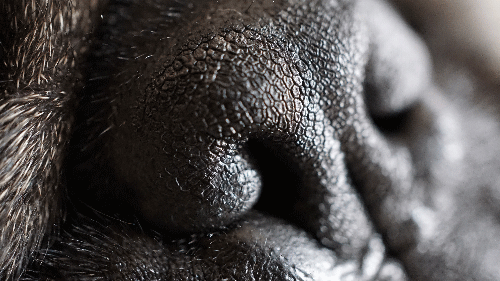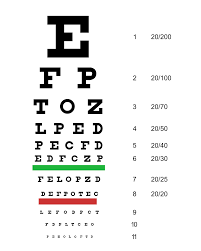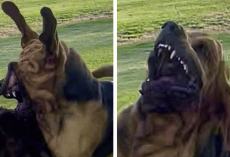Can Dogs See in Color?
Humans have three types of cones in our eyes, each one containing cells sensitive to its own color: red, green, and blue. This is called trichromatic. Dogs, on the other hand, only have two: blue and yellow. This is called dichromatic. So next time you’re wondering why your dog can’t seem to find that red KONG in the green grass, cut him some slack!
For instance, this is what a family photo looks like to a human:
And this is what it looks like to a dog:
Do Dogs See in Black and White?
Negative. This is a common myth, but dogs can see in more than just black and white. Dog eyesight captures blue, yellow, any combination of the two, and shades of gray.
Why Can’t Dogs See Like We Can?
Evolution, that’s why. Dogs are built for hunting and seeking out prey. That’s why their eyes have high sensitivity to motion at a distance — a whopping 10 to 20 times greater than humans. Their hunting background also means that their vision is suited for the hours just before sunrise and after sunset. Not only that, but dogs have a wider peripheral vision than humans.
What’s not important to dogs, however, is rummaging around for brightly-colored fruits and berries. Over time, their eyes adjusted to best fit their needs. It’s also worth noting that dogs rely more heavily on other senses, like smell. Thanks to the heavy lifting done by their extra-sensitive snout, dogs don’t have to see everything—they can smell it.
Why Do Dogs Have a Wider Peripheral Vision?
Chalk this one up to eyeball placement! Because dogs’ eyes live on either side of their heads, they can see an impressive 250 degrees. This is 60 degrees wider than their human friends, who max out at 190 degrees. Of course, there’s a range somewhere in the middle — a Labrador, for instance, has a much different facial structure than a pug.
The pro to having close-set, front-facing eyes? The central field of vision where both eyes intersect, which helps with details and depth perception. Where humans have this advantage, dogs do not.
Can Dogs See in the Dark?
If we’re comparing dog night vision to human night vision, then yes. Even though they have fewer cones than we do (remember, that’s what helps us see color), dogs have more rods, which help with the skills above: high sensitivity to motion and great vision during dawn and dusk.
SOURCE: INSTAGRAM USER JUNIORBULLDOG
Dogs also have large pupils, which, kind of like blinds, let in more light. Finally, because dogs are nocturnal by nature, they have a reflective membrane at the back of their eye called the tapetum lucid. This membrane acts like a mirror, bouncing extra light to the retina for bonus seeing power. Ever walked your dog at night or caught a glimpse of him in the dark? That is the sparkle you’re seeing.
How Accurate is a Dog’s Eyesight?
Well, not very. We’ve all seen the Snellen eye chart. If a human’s comfortable seeing 20/20, dogs are down at the 20/75 range. That means anything below the third line is a blur. Even without the finer details, however, dogs are still getting a basic, big-picture idea of the object or scene in front of them.
Source: Rover.com

















